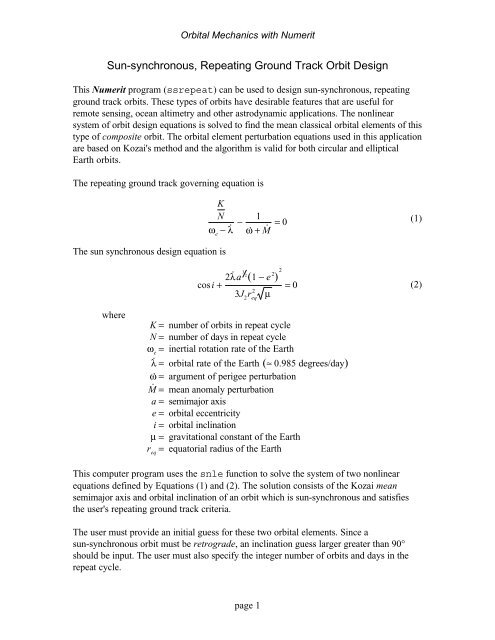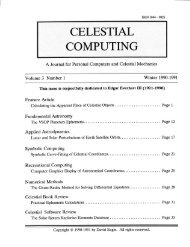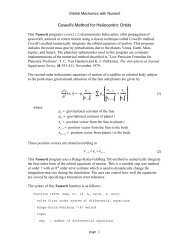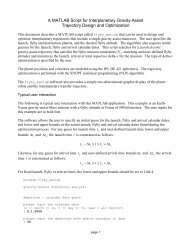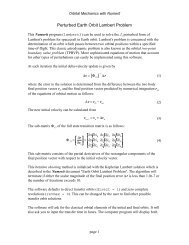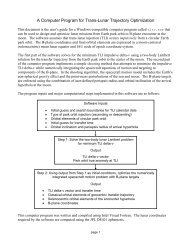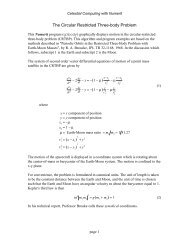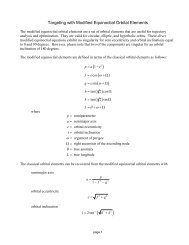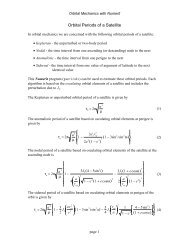Sun-synchronous, Repeating Ground Track Orbit Design
Sun-synchronous, Repeating Ground Track Orbit Design
Sun-synchronous, Repeating Ground Track Orbit Design
You also want an ePaper? Increase the reach of your titles
YUMPU automatically turns print PDFs into web optimized ePapers that Google loves.
<strong>Orbit</strong>al Mechanics with Numerit<br />
<strong>Sun</strong>-<strong>synchronous</strong>, <strong>Repeating</strong> <strong>Ground</strong> <strong>Track</strong> <strong>Orbit</strong> <strong>Design</strong><br />
This Numerit program (ssrepeat) can be used to design sun-<strong>synchronous</strong>, repeating<br />
ground track orbits. These types of orbits have desirable features that are useful for<br />
remote sensing, ocean altimetry and other astrodynamic applications. The nonlinear<br />
system of orbit design equations is solved to find the mean classical orbital elements of this<br />
type of composite orbit. The orbital element perturbation equations used in this application<br />
are based on Kozai's method and the algorithm is valid for both circular and elliptical<br />
Earth orbits.<br />
The repeating ground track governing equation is<br />
K<br />
N<br />
ωe − λ<br />
· −<br />
The sun <strong>synchronous</strong> design equation is<br />
where<br />
1<br />
ω · · = 0<br />
+ M<br />
cosi + 2λ· a 3 2 (1 − e 2 ) 2<br />
3J 2 r 2<br />
eq μ<br />
page 1<br />
= 0<br />
K = number of orbits in repeat cycle<br />
N = number of days in repeat cycle<br />
ω e = inertial rotation rate of the Earth<br />
λ · = orbital rate of the Earth (≈ 0.985 degrees/day)<br />
ω · = argument of perigee perturbation<br />
M · = mean anomaly perturbation<br />
a = semimajor axis<br />
e = orbital eccentricity<br />
i = orbital inclination<br />
μ = gravitational constant of the Earth<br />
r eq = equatorial radius of the Earth<br />
This computer program uses the snle function to solve the system of two nonlinear<br />
equations defined by Equations (1) and (2). The solution consists of the Kozai mean<br />
semimajor axis and orbital inclination of an orbit which is sun-<strong>synchronous</strong> and satisfies<br />
the user's repeating ground track criteria.<br />
The user must provide an initial guess for these two orbital elements. Since a<br />
sun-<strong>synchronous</strong> orbit must be retrograde, an inclination guess larger greater than 90°<br />
should be input. The user must also specify the integer number of orbits and days in the<br />
repeat cycle.<br />
(1)<br />
(2)
<strong>Orbit</strong>al Mechanics with Numerit<br />
The software will prompt you for an initial guess for the semimajor axis and inclination. It<br />
will also ask you to input the integer number of orbits and days in the repeat cycle. The<br />
program "hardwires" the value of mean argument of perigee to 90°.<br />
The following is a typical draft output created with this program:<br />
program ssrepeat<br />
< sun-<strong>synchronous</strong>, repeating ground track orbits ><br />
mean semimajor axis 7176.61579509 kilometers<br />
mean eccentricity 0.001<br />
mean orbital inclination 98.5964449811 degrees<br />
mean argument of perigee 90 degrees<br />
keplerian period 100.841487511 minutes<br />
nodal period 100.959413519 minutes<br />
number of orbits in repeat cycle 271<br />
number of days in repeat cycle 19<br />
ground trace repetition factor 14.2631578947<br />
For this example the semimajor axis initial guess was 8000 kilometers and the inclination<br />
initial guess was 100 degrees.<br />
page 2


